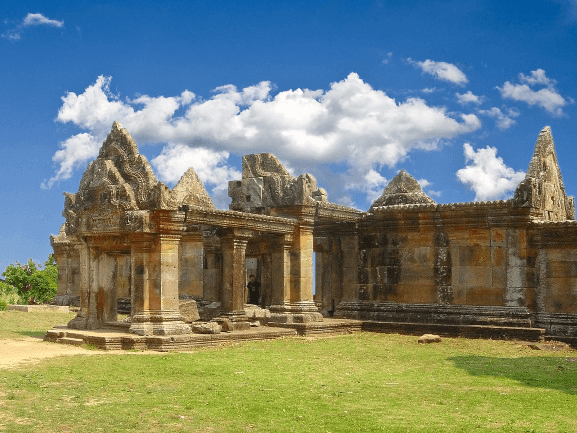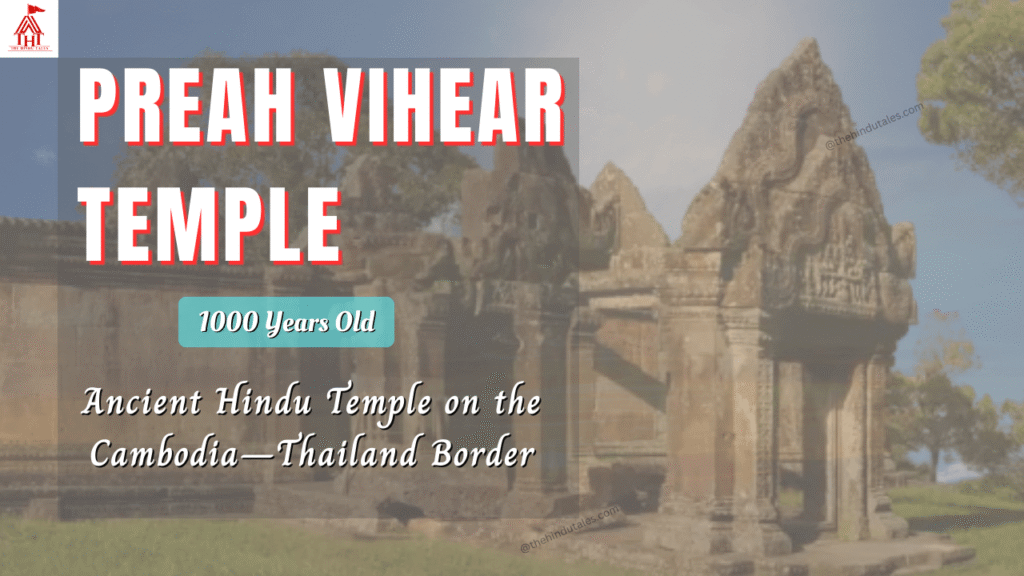Introduction
A Hindu temple in Hindu culture is an institution that plays a significant role in fostering an inclusive society. It unites people, brings them closer by heart, and aligns their actions for the benefit of society. The examples include BAPS Temple UAE, Angkor Wat Temple, Cambodia, BAPS Swaminarayan Akshardham Robbinsville, Batu Cave, Malaysia, and thousands more. These Hindu temples are seen as a symbol of cultural unity amid the diversification in society around the globe.
This is the reason why a Hindu temple in any part of the world is a matter of pride, and the same is true with Preah Vihear Temple, a Hindu Temple, on the border of Thailand and Cambodia. But the sad thing is that the two countries have been fighting for the ownership of this age-old temple for years. The recent escalation of news between their military brought the temple into the spotlight once again.
Therefore, if you are unaware of this age-old Lord Shiva Temple, and are puzzling your head to find out the root cause of escalation, read this article to learn about the temple and its significance for the world.
Preah Vihar Temple: Location & Historical Overview
Preah Vihear Temple is a thousand-year-old historic Hindu temple dedicated to Lord Shiva. It was built around the 9th century under the reign of the Khmer empire. The temple is strategically located on Dangrek Mountain in Preah Vihear province of Cambodia. This mountain region is the natural border of Thailand & Cambodia. Hence, a matter of dispute between the two countries over the ownership. It has also been awarded the UNESCO World Heritage Site and, therefore, a monument of historical significance.

Lord Shiva: The Central Deity Of Preah Vihear Temple
The Khmer Empire built Lord Shiva’s temples featuring the magnificent and divine Shivlinga. Their political ideology was influenced by Lord Shiva; hence, to showcase their divine connection with the deity, they built several temples dedicated to Lord Shiva. Preah Vihear Temple is one among them.
Lord Shiva is one of the most revered Hindu deities for Hindus. He is known as the supreme among all the Hindu gods; hence, entitled as Mahadev, meaning ‘the lord of all other gods’. He is known for his furious nature, immense love, cosmic dance, yoga teachings, meditation, and angry destruction.
He lives an ascetic life, resides on Kailash in the Himalayas, and engages in Sadhna most of the time. He is depicted having three eyes, long hair, Jata, trident in one hand, snake around the neck, damru fixed on the trishul, adorning a crescent moon on the forehead, and wearing a tiger skin on the waist part of the body.
He is the consort of goddess Parvati, who herself is regarded as ‘Mahashakti’, ‘Adishakti’, ‘Navdurga‘. Therefore, Lord Shiva is known as ‘Adipurush’, ‘Adiyogi’, ‘Chandrashekhar’, ‘Kailashpati’, ‘Trishuldhari’, ‘Mahayogi’, and a thousand other names.
Khmer Empire & Its Religious Legacy
In history, the Khmer Empire is admired as a renowned & powerful empire in Southeast Asia that existed from 802 CE to 1431 CE. It was Jayavarman II, who is credited with starting the Khmer empire in 802 CE, which began to fall after the 13th century.
They are also known as the Angkor Empire and their reign period as the Angkor Period. Because Angkor was the capital city of the Khmer Empire, it derived its name from the name of the city. Angkor Wat Temple is the world’s largest Hindu temple in Angkor, in the name of Angkor city, which was also built during the reign of the Khmer Empire.
Angkor became a significant city in Cambodia during the Angkor period. A large number of impressive temples and significant monuments were built in the city during the Angkor Period. It helped the city become the spiritual centre of that time. The other renowned and world-famous monuments & temples built during the Khmer empire include Angkor Wat Temple, Bayon Temple, Preah Vihear Temple, and many more.
The Khmer Empire is known for its architectural mastery, which is reflected in the intricately carved temples and monuments during its reign. They built the temples in a unique architectural style while drawing inspiration from Bharat (India). They are heavily influenced by Indian temple architecture. Thus, they built temples mirroring the Indian styles and culture. The temples and monuments that they built during their time are standing by with pride till today, telling the story of the Khmer Empire’s grandeur and artistic achievements after a thousand years.
Preah Vihear Temple Architecture
The Khmer king Suryavarman II, during his reign, built the Preah Vihear Temple around 1000 years ago in a unique architectural style. It is an outstanding masterpiece of Khmer architecture and stands apart from other temples in Cambodia.
Where other temples in Cambodia are rectangular, the Preah Vihear Temple, situated on top of a 525-meter cliff of the Dangrek Mountain range, is constructed along a long North-South axis connecting buildings, paths, and staircases along an 800-metre stretch in series. The temple has been built using gray and yellow sandstone, featuring five gopuras successively, thus each making an entry point for the temple.
Thailand – Cambodia Dispute Over The Temple
Thailand and Cambodia are the Buddhist countries in Southeast Asia that have been fighting for the ownership of Preah Vihear Temple since 1904-1907. During 1904-1907, the border between the two countries was decided by the Franco-Siamese treaties. It stemmed the dispute because the demarcation map was showing the temple on the Cambodian side of the map, while on the mainland, it was on the Thailand side in the line of the Dangrek mountain watershed.
Thus, it played a key role in escalating tensions between the two. Later, when Thailand gained independence in 1953, it occupied the Preah Vihear Temple in 1954. It resulted in the first official conflict between Thailand and Cambodia.
The matter was brought to the International Court of Justice (ICJ), and, in 1962, the ICJ awarded the ownership of the temple to Cambodia. But, still, the dispute has not been solved completely and is alive in the minds of both nations, resulting in frequent clashes and fights between the two Buddhist countries.
Spread of Buddhism In Cambodia
Cambodia was heavily influenced by Bharat (India), the Hindu religion, and the Hindu culture. Therefore, the society in Cambodia was arranged in the Hindu hierarchy system – Brahmin, Kshatriya, Vaisya, and Shudra.
With the Hindu influence in the society, the Buddhist philosophy and concept also entered Cambodia and spread widely through Hindu merchants, intellectuals, and Indian philosophers.
Both religions flourished together in Thailand and Cambodia, even during the Angkor period, under the reign of the Khmer Empire. Hence, it is no wonder that despite being Buddhist countries, the Hindu temples are considered the age-old heritage of the country and are considered a matter of pride.
Visiting Preah Vihear Temple
Preah Vihear Temple is located on the border region of Thailand and Cambodia, but Cambodia holds the ownership of the temple. Hence, to reach Preah Vihear Temple, you can choose to fly to Cambodia first. Phnom Penh International Airport and Siem Reap International Airport are the two main airports that you can choose as your destination when flying internationally.
- Distance of Preah Vihear Temple from Phnom Penh ~ 418 km
- Distance of Preah Vihear Temple from Siem Reap ~ 218 km
After reaching Phnom Penh or Siem Reap, you can reach the Preah Vihear Province by taking a bus or by reserving a private vehicle – taxi or cab. Finally, after an adventurous journey of several hours, you will reach Srayang, which is the base city for your entry into Preah Vihear Temple. Here, you can book accommodation, have your meals, and become refreshed.
Because the temple is located in a remote region on Dangrek Mountain, you will need to obtain permission from the Cambodian government to visit the temple. It involves entry fees, hiring local guides, and understanding the instructions from the authority.
Once you are permitted, visit the temple complex, enjoy the panoramic mountain view, and wonder about the ancient architectural beauty of the Khmer empire. Please don’t forget to be respectful and mannered when visiting the temple, as it is a temple and holds religious significance.
Conclusion
In the end, Preah Vihear Temple is a monument of historical, spiritual, and religious significance. It is a living embodiment of our shared cultural heritage and ancient architectural mastery. The countries should not be involved in any kind of dispute or conflict over the ownership of the temple. The temple is an asset to the world, and after getting recognised as a UNESCO Heritage Site, it is our responsibility to protect and preserve the temple. This is the only way by which we can sustain our thousand-year-old legacy for future generations.
Frequently Asked Questions (FAQs)
Q1. Preah Vihear Temple is dedicated to which god?
Ans. Preah Vihear Temple is a Hindu temple dedicated to Lord Shiva.
Q2. Who Built the Preah Vihear Temple?
Ans. The Khmer kings of the Khmer Empire built the Preah Vihear Temple between the 9th and 12th centuries. However, the exact date is unknown; Suryavarman I and Suryavarman II are credited with building most of the temple parts.
Q3. What is the Preah Vihear Temple dispute?
Ans. Preah Vihear Temple is not a dispute but a symbol of shared heritage and cultural unity. It is a legacy situated on the border region of Thailand and Cambodia. Therefore, there is a dispute over the ownership of the temple.
Q4. Why are Thailand and Cambodia fighting over the Preah Vihear Temple?
Ans. Thailand and Cambodia are fighting over the ownership of the Preah Vihear Temple. They consider the temple as an important part of their age-old heritage and have deep sentiments attached to the temple.


